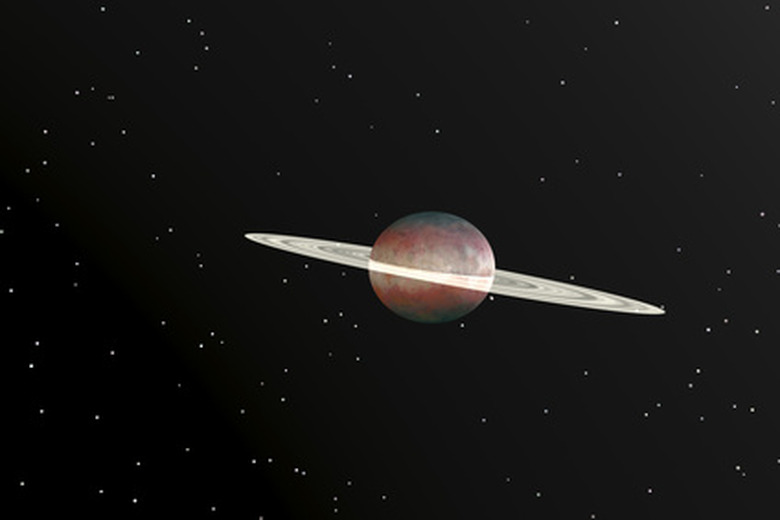Amazing Facts On Saturn
Saturn is 95 times bigger than Earth and lies sixth from the sun in our solar system, between Jupiter and Uranus. Its distinctive rings and pale silver color make it one of the most recognizable planets through a telescope. Saturn falls into the gas giant, or Jovian, classification of planet.
Surface
Surface
NASA scientists believe Saturn to be made up mostly of swirling layers of gas with a small iron and rock core–though its strangest feature is a sticky layer of compressed gas. From the core outward, NASA scientists believe, Saturn is composed of several identifiable layers. Ammonia, methane and water make up the outer core; then, there's a layer of highly compressed metallic hydrogen. That's covered by a viscous layer of compressed helium and hydrogen that gradually becomes more gaseous the higher it gets from the surface.
Atmosphere
Atmosphere
Saturn is covered by a thick layer of cloud, stretched into bands around the planet by 1,100-mph winds. No animal or plant life from Earth could survive on Saturn, and NASA scientists doubt the planet is able to sustain life of its own.
Temperature
Temperature
Saturn tilts on its axis away from the sun. This means heat from the sun warms the southern hemisphere more than the northern hemisphere. Because of its distance from the sun, 840 million miles compared to Earth's 91 million, Saturn's outer clouds are extremely cold. NASA instruments measure the average cloud temperature to be minus 175 degrees C (minus 283 degrees F). Below the clouds, NASA believes the temperature to be much higher and estimate Saturn gives off 2.5 more heat than it receives from the sun, largely due to a chemical reaction between the planet's liquid hydrogen and helium.
Density and Mass
Density and Mass
While Saturn is much larger in size than Earth, it is much less dense–so much so that NASA scientists believe a chunk of Saturn would float in water. A cube of Earth's surface would be much heavier if it were to be weighed against an equal-sized cube from Saturn. The gravity on Saturn is estimated to be slightly stronger than that of Earth, so a 100-pound object on Earth would weigh 107 pounds on Saturn.
Rings
Rings
Saturn's most recognizable features are its rings, the largest of which is more than180,000 miles wide but only a few thousand feet thick. The rings surround Saturn at its equator but do not make contact with planet itself. In total Saturn has seven rings, each made up of thousands of smaller ringlets. These ringlets consist of billions of particles of ice, some as small as dust and some pieces as large as 10 feet across. Although Saturn's rings are extremely wide, they are incredibly thin, almost invisible when viewed in profile from Earth.
Moons
Moons
Saturn has 62 moons that measure more than 31 miles in diameter, and many smaller "moonlets." The largest moon, Titan, is about half the size of Earth and larger than the planet Mercury. It is the only one to have its own atmosphere, which is mostly made up of nitrogen. Other Saturnian moons include Mimas, with its massive crater taking up more than a third of its surface, and Hyperion with its cylindrical shape.
Missions to Saturn
Missions to Saturn
The latest probe to orbit Saturn was Cassini-Huygens, launched in 1997 as a joint mission of the European Space Agency, NASA and the Italian Space Agency. One of the largest interplanetary spacecraft ever built, Cassini spent seven years flying toward Saturn, its rings and moons. In 2005 the Cassini spacecraft deployed the Huygens probe to study Titan.
Scientists have been studying Saturn with probes since 1973, when NASA launched Pioneer 11 to analyze Saturn and Jupiter. It passed within 13,000 miles of Saturn in 1979 and sent back scientific data and the first close-up photographs of Saturn. This information led to the discovery of two of Saturn's rings and its magnetic field. In 1977 NASA launched Voyager 1 and Voyager 2, which both passed closer to Saturn, in 1980 and 1981, respectively, than Pioneer 11 did. Both Voyager missions provided NASA with details of Saturn's moons and additional information on its rings.
Cite This Article
MLA
Stefansson, Jon. "Amazing Facts On Saturn" sciencing.com, https://www.sciencing.com/amazing-saturn-7237447/. 24 April 2017.
APA
Stefansson, Jon. (2017, April 24). Amazing Facts On Saturn. sciencing.com. Retrieved from https://www.sciencing.com/amazing-saturn-7237447/
Chicago
Stefansson, Jon. Amazing Facts On Saturn last modified August 30, 2022. https://www.sciencing.com/amazing-saturn-7237447/
